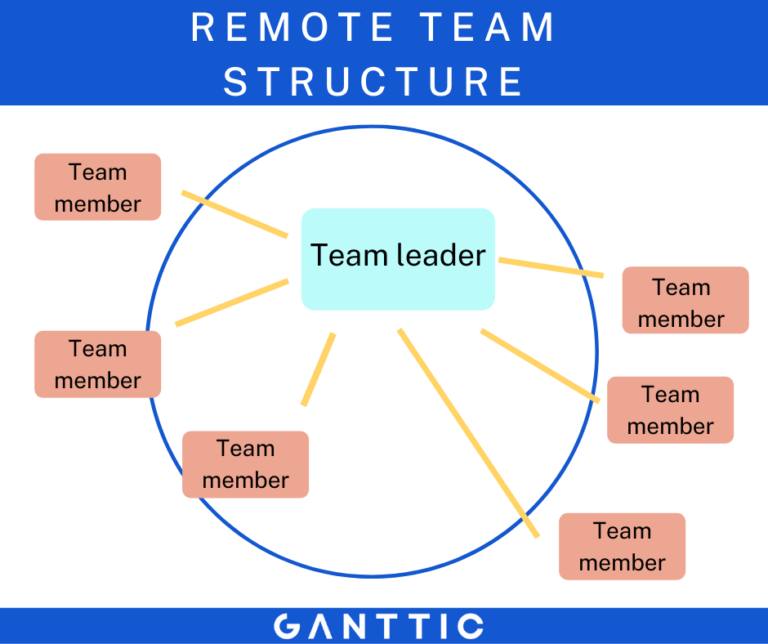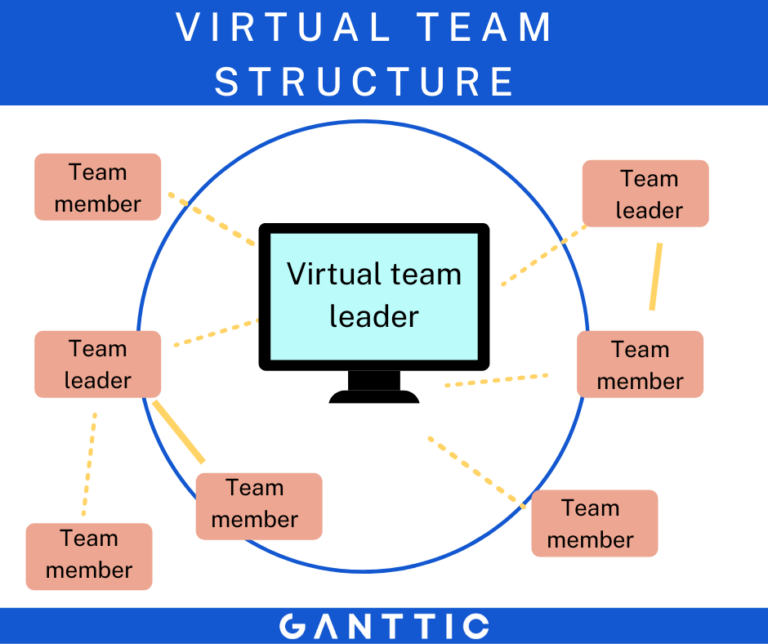Virtual teamwork is a reality for many offices.
From the invention of the 8 hour workday, to Henry Ford’s creation of the weekends. And now to debates on whether we should cut the working day and week down even more. Working from home, digital nomad lifestyles, and hybrid workplace models are the next generation of office work.
Especially with the advent of better technology, employees are no longer tethered to their desks. Which means that in a lot of the places, the traditional brick and mortar offices are going the way of the Model T.
And statistics show that this trend will only keep going up. This kind of team structure provides flexibility and comfort to employees, while also giving a boost to productivity and increasing employee retention.
Whether they are born out of necessity or desire to be location independent. And no matter if you are fully remote, semi-virtual, or somewhere in between, virtual teams are looked upon as a great option for companies hoping to save money, grow their business, and assemble the best online workforce they can find.
Virtual teams: Quick stats & overview
- 89% of virtual teams in the world include more than two cultures.
- Good virtual teammates share the following traits: share information (19%), collaborative (18%), proactively engaged (17%), and organized (14%)
- 85% of employees involved in global business activity work on virtual teams. Of this, 89% work in at least one team, and a whopping 27% are in more than four virtual teams
- Also, 85% of businesses think that flexible working policies, helps them be more more productive.
As you can see, there’s a lot of reasons to go virtual, if you haven’t already. So whether you’re looking for some tips or a guide to get you started, we’ve got you covered.
Here we’ll provide you with a comprehensive guide on virtual teams. We’ll get into the nitty gritty details and explain the difference between the differing terms (remote, virtual, dispersed, oh my!). As well as some of the different kinds of virtual teams you might encounter. We’ll also give you a few reasons to implement this structure and what kind of benefits you’ll see once you do.
We will also provide you with 3 tips to keep in mind for better globally dispersed management. By the end, we promise you’ll be a virtual team master and ready to tackle this new way of working.
Let’s get to it!
What are virtual teams?
The definition for virtual team is one that is geographically scattered, but connected through their shared use of technology. Virtual team tools can include video conferencing, email and other messaging tools, project and resource planning software, and virtual collaborative workspaces, among others.
Virtual teams may work together asynchronously or even across organizational levels. And in one team, the various members might report to different bosses.
They may be fully remote and scattered all over the world. Or even just a semi-virtual team, scattered over across town.
In general, virtual teams can also be called remote, dispersed, global and distributed teams. And the last three can be used interchangeably.
However, with a remote team, there are some nuances between the concepts.
Virtual teams VS. remote teams
 Remote teams are usually characterized by a “solid line” structure.
Remote teams are usually characterized by a “solid line” structure.
By definition a remote team is composed of people who are not geographically co-located. This can include digital nomads, teleworkers and telecommuters, or people from the same company who work in different branches or on different continents.
Regardless of their positions, the entire team all works directly for a manager. A for example, with remote teams meaning there is a “solid line” of reporting.
A virtual team is a group of people who are brought together to perform specific tasks or resolve specific issues. Some of them may be co-located, but the term usually refers to geographically dispersed teams.
This structure consists of people who work for different line managers, who then might report to other project managers for a short amount of time. Or they might be brought in as consultants from clients, freelancers, or hired by the organization to give their expertise. They are then characterised by this “dotted line” reporting.
These two types have all the same struggles, challenges, and benefits of not being co-located. The major difference is merely the reporting structure.
However, in a virtual team, members can be added for specific tasks for merely a short amount of time. As such, the manager of a virtual team might not have “hiring and firing” power over their team.
Virtual teams VS. dispersed, global, and distributed teams
 Virtual teams are characterized by a “dotted-line” and mixed structure.
Virtual teams are characterized by a “dotted-line” and mixed structure.
When it comes to virtual and dispersed, global and distributed teams, there tends to be more confusion. This is because many times they are referring to the same kind of team structure, but place emphasis on different aspects.
Virtual teams focus more on what brings the team together – technology. While the terms dispersed, global, and distributed emphasize what keeps them apart – distance.
The choice can also depend on the structure of your organization, as distributed and dispersed does not necessarily mean global. In fact, the team members might be located in the same city or even the same building, but not all together.
The term global team can also refer to a specific type of virtual team. This is one in which members from various countries with a diversity of cultures, thoughts, needs, and solutions are brought together to perform a particular purpose or task.
Origins of virtual teams
Virtual work was born out of telecommuting. This practice began in the 1970s and 80’s, from a mix of factors. More women were entering the workplace, and family commitments pushed for changes in work structures. This was helped with the rise of technology, when fax machines, cell phones, personal computers, and the world wide web came along. Changing the whole technological landscape.
Right away many businesses saw the benefits that virtual team work afforded them. And this practice has been steadily rising over the years. Even though many people see virtual teams as a recent phenomenon, examples have been around for decades.
Virtual teams are used in every profession from IT, to services, to engineering, and even healthcare.
Different types of virtual teams
Although, there are a number of different types of virtual teams, here we’ll dive into just a few examples.
Networked teams
Dispersed teams which are composed of experts in different fields formed to discuss specific topics or solve particular problems. They can come from the same or different organizations.
Characterized by their fluid membership, new members are added as necessary and existing members are removed whenever their role is completed. The networked teams dissolve when the assigned task is completed. These types of teams are widely used in consulting firms and technology companies
Parallel teams
Task oriented teams that usually consist of specialized professionals from inside or outside the organization. They are generally only required for a short amount of time, but are not dissolved after the completion of their tasks.
This type is effective in multinational organizations where a global perspective is needed to make recommendations for the local adaptations of products. For example, a consumer goods company might team up their sales, R&D, marketing, and manufacturing professionals from different locations into parallel virtual teams.
Project development teams
Precursor to modern virtual teams developed in the 1990s which brought together specific experts from different parts of the world. Virtual project teams usually work to develop a new product, information system or process. They are typically found in the R&D division of product-based companies.
Service teams
Service teams are internationally dispersed over different time zones. Commonly found in customer service, they work to provide a service for all hours of the day.
Virtual teams vs. traditional teams
Why do organizations turn to virtual teams? There are a number of reasons and motivations for a company to assemble such structures. One reason being that they can actually bring out a number of benefits. Especially when contrasted to a traditional team structure. Some of these benefits include:
Reduced operation costs – virtual teams actually save companies a lot of money! Don’t believe us? It’s been shown that if employers let their employees work from home even some of the time, it would save the company on average 11,000 USD annually.
Think about it. How much would you save if you didn’t pay for an office space, or on equipment and furniture that comes with it? And if you could pay people according to the work they do, not their location?
Take for example the fact that the average marketing manager’s annual salary in New York is 161,000 USD, while in Michigan it’s 108,000 USD. This team structure allows for you to pick your team based on talent, not on what your company can afford. And speaking of talent, that brings us to our next point.
Access to global talent – Allowing your employees to connect virtually let them connect from anywhere. That means you don’t need to limit your hires to the local job market.
This opens up opportunities to hire talent from all over the world. This can be beneficial if you are working on something which requires local insight, like for example launching a new product in Singapore. If you already have locals on your team, that makes the launch process a hell of a lot easier and smoother. Plus, global talent means more diversity, which studies show helps productivity and efficiency and leads to our last point.
Faster to problem solve and innovate – Virtual teams are great for problem solving. Why? Because not only do they have access to the best talent, but you have the best talent coming from a variety of backgrounds.
This makes it easier to source new ideas, think of unique solutions, and create more innovative products. Plus, because remote workers tend to be more productive, more flexible, and more independent, you can see results more quickly.
Types of Conflict in Virtual Teams

Although this structure can provide a lot of advantages for a company, there are always some challenges team members will need to overcome.
Communication misunderstandings – differences in cultures, languages, and internet connections are oftentimes exacerbated by finicky technology and a lack of clear objectives.
Scheduling snafus – multiple projects, teams, and time zones can be a recipe for disaster if bottlenecks and overbookings aren’t caught ahead of time. Especially if your PM is still using Excel for your project management.
Management issues – this kind of team structure requires significant trust and isn’t well suited for micromanagers. Plus, without “hiring and firing” power, managers may find it difficult to motivate some employees.
However intimidating these challenges are there are some surefire ways to overcome them. And many of these difficulties can be mitigated by following some virtual team management tips.
How to Manage Virtual Teams Effectively
There are dozens of tips and management techniques for making sure you have the most effective virtual team. To make it simple, we have narrowed it down to the 3 important things to keep in mind.
- Get inspired by other virtual teams
- Use the right virtual team technology
- Stay flexible
Get inspired by other virtual teams
Although every company has their own unique challenges, there can be a lot to learn from how others effectively manage their virtually dispersed teams. Seeing what others experience can be a useful guide, as it can highlight many of the likely pitfalls, while also inspiring how to move forward.
Companies such as GitHub and Zapier operate with fully remote teams, while other major corporations such as Google and Dell have implemented specialized conditions in the wake of the current pandemic.
You can also search out other companies and take a lesson on how they operate. Here’s a list of 125 other companies that are fully remote whose blogs it might be useful to check out.
Here at Ganttic we’ve been around for more than 10 years, and in that time we have witnessed how teams from very different industries have used resource planning software in their organizations. Below are a few ways that teams in creativity and engineering have been able to solve their global resource management needs.
KiteTeam
KiteTeam is a Spanish based company, which localizes video games all over the world. This creative company with offices in Madrid, Brazil, and Mexico, uses resource planning to keep track of their sound teams and recording studios. Saying:
“Basically, we used to be three different companies. We were looking for a resource management tool that would make it possible to make schedules for all three recording studios. We need to see who is using which recording studio, at what time they’ll start and at what time they are done.”
With a flexible scheduling platform, the team can book an actor, creative engineer, audio engineer or any resource all at once. No matter their location.

Using different planner Views allows KiteTeam to, “control the bookings of actors.” They can also create different Views for meeting room availability or Views for each of the multiple projects they work on.
Then by adding custom data fields to the resources or projects, their PM can specify certain criteria:
“Thanks to the custom data fields we can enter all the information that one could imagine. When work is already in progress, we use the custom data fields to filter out projects, resources, and tasks that we need.”
Not only does resource management software help give a centralized overview to the PM, but using different views and filtering out certain data fields, gives an overview of what exactly they need. Management without getting bogged down by an information overload. Noting,
“It’s the big picture that we are after and it’s what we get with Ganttic.”
Pure Technologies Ltd.
Over in a completely different industry, Pure Technologies Ltd. is an international asset management technology and services company. Looking for a more efficient solution to their human resource and equipment scheduling problems, they found Ganttic. Manager Allison Stroebele told us:
“We needed a better way to schedule a project so that we could see who would be involved and what equipment would be in use. Especially when teams were coming from three different offices nationwide and equipment was being shipped from anywhere in the country. We can track at least 80 pieces of equipment now as well, which wasn’t practical previously…. it gives everybody better visibility on where equipment and technicians are and what they’re doing. ”
Another useful aspect that’s great for virtually dispersed teams is the online resource planning software which gives instant insight to any changes. As Alison says:
“We use it every day and all 8 managers use it at the same time. Sometimes we’re on the phone together and we giggle, because somebody changes something and it changes on my end instantly, and everybody loves that.”
Allison Stroebele, Manager